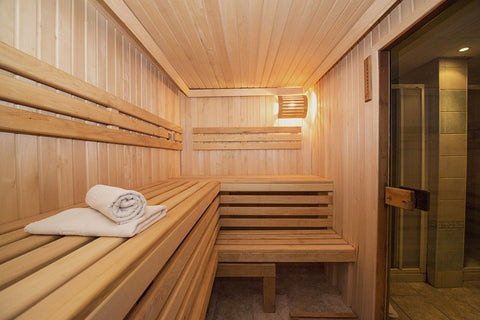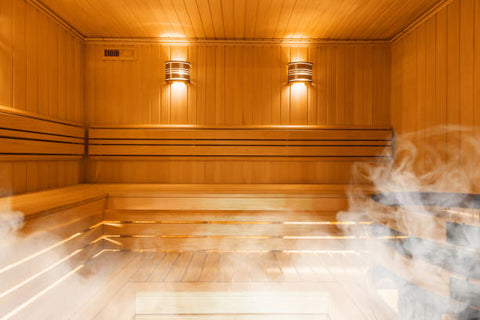The Pros and Cons of Traditional Saunas
Hot Topic: The Pros and Cons of Sauna

As interest in wellness and alternative therapies rises, saunas are growing in popularity. Public recreation centers, gyms, and even homes now feature saunas alongside pools, hot tubs, and steam rooms. From the steamy humidity of traditional saunas to the dry heat of infrared saunas, these hot rooms offer health benefits.
Sauna enthusiasts claim that regular dry sauna bathing reduces stress, relieves pain, improves cardiovascular health, and provides other benefits. But do all these assertions have any scientific basis?
In this blog post, we’ll explore the potential pros and cons of saunas. We’ll also examine any risks and things to keep in mind. By evaluating the facts, we hope to provide a balanced look at this steamy therapy so you can determine if it’s right for you.
Steam Bathing vs. Sauna: Weighing the Benefits and Risks

When comparing steam bathing and traditional saunas, it's important to consider both their benefits and potential risks, especially concerning time-frame dangers. Steam baths, known for their high humidity levels, are excellent for skin hydration and respiratory relief. However, staying in a steam room for extended periods can lead to overheating and dehydration. On the other hand, traditional saunas offer dry heat, which is effective in raising the core temperature and promoting detoxification through sweating.
One key difference lies in how these environments affect body temperatures. In traditional saunas, the dry heat can raise body temperature more efficiently, which is beneficial for muscle relaxation and stress relief. However, this also means that one should be cautious of the duration spent in a sauna to avoid overheating or dehydration.
While both steam baths and saunas provide relaxation and potential health benefits, it's crucial to be aware of their respective limitations and to use them responsibly.
The Health Benefits of Sauna Use (Pros)
Sauna use has long gained popularity for its health benefits. Sauna sessions have many potential advantages, from detoxification to improving cardiovascular health. Below, we explore some key health benefits linked to sauna use.
Regular Sauna Use May Help with Detoxification Through Sweating
One of the most well-known sauna benefits is detoxification. As you relax in the sauna's heat, your skin temperature rises, leading to a deep sweat. Moist heat helps flush out the toxins and impurities from your body. Sweating may also improve your skin health. It can cleanse the skin, promoting a clearer, healthier complexion.
Regular Sauna Use May Help with Cardiovascular Health and Blood Circulation
Regular sauna use may have the potential to offer several cardiovascular benefits. The sauna heat causes your blood vessels to dilate, improving circulation and lowering blood pressure. This enhanced blood flow not only aids in muscle relaxation but also ensures more oxygen and nutrients are delivered throughout the body.
Studies have indicated that regular sauna use can be like mild exercise for the heart, potentially reducing cardiovascular disease risk.
Regular Sauna Use May Help with Stress Relief and Mental Health Benefits
Saunas are not just healthy for the body; they can also be healthy for your mind. Saunas are excellent places for relaxation and meditation, reducing stress and anxiety levels. The heat relaxes muscles and releases tension, while the quiet, isolated space offers a retreat from the daily grind. When your body absorbs the heat from a sauna, your heart rate increases, and endorphins are also released. The endorphins act as natural pain relievers that can help reduce stress. Many users report improved sleep patterns and mental well-being following sauna sessions.
Regular Sauna Use May Help with Immune System Boost and Illness Prevention
Regular sauna use may also strengthen the immune system. Heat exposure during a sauna session can stimulate white blood cells that fight infections and illnesses. The increase in body temperature can simulate a fever state, which is the body's natural mechanism for strengthening and accelerating the immune response. This aspect of sauna use may help reduce the likelihood of catching colds and flu and even aid in faster recovery when you are ill.
Sauna use has vast and varied health benefits, including physical, mental, and emotional well-being. Whether it's detoxifying the body, improving heart health, relieving stress, or boosting the immune system, the pros of incorporating sauna sessions into your wellness routine are certainly compelling.
Regular Sauna Use May Help with Weight Loss
Incorporating sauna sessions into a healthy lifestyle routine can be a beneficial tool for weight loss. The heat from steam rooms or dry saunas not only promotes relaxation but also enhances blood circulation and can temporarily lower blood pressure. While primarily facilitating water loss, the increased heart rate in a sauna can mimic a mild workout, aiding calorie burn. An interesting addition to this regimen is the use of a sauna suit, which intensifies the effects by increasing body temperature and potentially boosting weight-loss efforts. Saunas, when used as part of a balanced wellness approach, offer these and other health benefits, making them a valuable component of a holistic health and fitness plan.
Potential Risks and Downsides of Saunas (Cons)
While sauna use offers numerous health benefits, it is essential to be aware of its potential risks and downsides. Understanding these can help users enjoy saunas safely and responsibly.
Dehydration and Overheating During a Sauna Session
One of the primary concerns about sauna use is dehydration and overheating. As your body sweats to cool down in a sauna, it loses a lot of fluid. If these fluids aren't restored, dehydration may ensue, marked by symptoms such as dizziness, headaches, and intense thirst. Additionally, staying in a sauna room for too long or at an excessively high temperature can lead to overheating, potentially resulting in heat exhaustion or heatstroke—serious conditions that require immediate medical attention.
Risks for People with Certain Health Conditions
Sauna use is not suitable for everyone, especially individuals with certain health conditions. People with cardiovascular issues, such as high blood pressure or heart disease, should be cautious, as high temperatures can strain the heart.
Similarly, those with respiratory problems might find breathing difficult in a hot and steamy environment. Pregnant women are advised to avoid saunas, as overheating can harm a developing fetus. Anyone with health concerns must consult a healthcare professional before incorporating sauna sessions into their routine.
Moderation and Safe Practices in Using a Sauna
To minimize risks, practice moderation and follow safe sauna use guidelines. This includes limiting regular sauna sessions to a recommended duration—typically not more than 15-20 minutes. Avoid alcohol before or during sauna use, as it can increase the risk of dehydration and hypotension (low blood pressure).
It's also advised to cool down gradually after a sauna session and rehydrate by drinking plenty of water. By adhering to these practices, sauna users can enjoy the benefits while mitigating the potential risks.
While saunas offer numerous health benefits, know and manage the risks associated with their use. Proper hydration, understanding personal health limitations, and practicing moderation are key to achieving a safe and enjoyable sauna experience.
Comparing Different Sauna Experiences

Sauna experiences vary depending on the type of sauna and the setting in which it is enjoyed. Here, we'll explore the differences between traditional steam saunas and infrared saunas. We'll compare public saunas with home saunas and explore how sauna practices vary across cultures.
Traditional Steam Sauna vs. Infrared Sauna
Traditional steam saunas, also known as traditional Finnish saunas, often made of wood and heated with rocks, operate at high temperatures (usually between 150°F and 195°F) and often include the option of pouring water on heated stones to generate steam. This type of sauna is known for its intense heat and high humidity, which promote sweating and relaxation.
On the other hand, infrared saunas utilize infrared heaters to produce a distinct wavelength of light, which the body directly absorbs. This heats it from the inside out. Operating at lower temperatures (usually between 120°F and 150°F), infrared saunas provide gentle, dry heat. This difference can make infrared saunas more comfortable for people who find traditional steam saunas' high heat and humidity overwhelming.
Each type offers distinct potential benefits. Traditional saunas are excellent for intense detoxification and relaxation. In contrast, infrared saunas are praised for providing deep, penetrating heat that soothes muscles and joints more effectively.
Public Saunas vs. Home Saunas
The choice between public saunas and home saunas also shapes the sauna experience. Public saunas in gyms, spas, or dedicated sauna facilities offer a social aspect and often have larger, more varied facilities. They can be a great way to unwind after a workout or a spa day.
Home saunas, on the other hand, provide privacy and convenience. They allow for a more personal and customized sauna experience, such as setting the preferred temperature and duration or even the type of sauna (steam or infrared). However, installing and maintaining a home sauna can be a significant investment in both cost and space.
Barrel Sauna vs Himalayan Salt Saunas
When comparing the Barrel Sauna and the Himalayan Salt Sauna, two distinct sauna experiences emerge. Barrel saunas, with their traditional steam room environment, excel at promoting improved blood circulation and can be beneficial for managing blood pressure. The cylindrical design of a barrel sauna is one of its pros; often crafted from durable woods like cedar, it uses less energy to heat and also provides a consistent distribution of warmth, which is key to a deep, relaxing sauna experience. This contrasts with the Himalayan Salt Sauna, where the walls are lined with pink Himalayan salt blocks. These blocks are believed to emit negative ions when heated, creating a soothing atmosphere that can be especially beneficial for individuals with low blood pressure. The mild heat of the Himalayan salt sauna offers a gentler option compared to the more intense heat of barrel saunas, making it a preferred choice for those seeking a more relaxed sauna session.
While both sauna types offer unique health benefits, such as aiding relaxation and potentially providing other health advantages, they cater to different preferences and health needs. The Barrel Sauna's intense heat is ideal for sauna purists seeking a traditional steam experience, whereas the Himalayan Salt Sauna's gentle warmth and ionized air provide a modern twist on wellness, potentially offering respiratory and skin benefits. It's important, however, for sauna users, particularly when considering factors like drinking alcohol, to be mindful of their health and wellness, as alcohol consumption can affect the body's response to heat and dehydration. Ultimately, whether you choose the rustic charm of a barrel sauna or the holistic approach of a Himalayan salt sauna, both present unique pathways to relaxation and wellness.
Cultural Variations in Sauna Practices
Sauna practices vary widely globally and are deeply rooted in cultural traditions. In Finland, saunas are a vital component of cultural traditions, frequently followed by immersion in a chilly lake or rolling in snow. Russian banyas, similar to saunas, involve a ritual of hitting birch leaves to stimulate circulation. In Turkey and the Middle East, hammams, or steam baths, are communal cleansing and relaxation rituals.
These cultural variations extend to the etiquette, rituals, and even the architecture of the hot sauna or steam bath. This offers a glimpse into the diverse ways people worldwide enjoy this age-old practice of sauna bathing.
The sauna experience is diverse and multifaceted. Whether it’s the type of sauna, the setting, or the cultural practices surrounding it, each aspect contributes to the unique and therapeutic experience that saunas provide.
Making the Most of Your Sauna Experience

Understand and adhere to best practices, and take proper care before and after your sauna to maximize the benefits and enjoyment of sauna sessions. Integrating sauna use into your regular wellness routine can elevate your overall health and well-being.
Best Practices for Sauna Use
Stay Hydrated: Drink plenty of water before, during, and after your regular sauna session to replenish lost fluids due to sweating and to.
Duration and Temperature: For beginners, start with shorter sauna sessions (around 5-10 minutes) and gradually increase as you get used to the heat. The ideal temperature is subjective but generally ranges between 150°F and 195°F for traditional saunas and 120°F and 150°F for infrared saunas.
Listen to Your Body: Exit the sauna if you feel dizzy, nauseous, or uncomfortable. It's imperative to recognize your body's signals and not overdo it.
Avoid Alcohol and Heavy Meals: Refrain from consuming alcohol or heavy meals before using a sauna, as these can affect your body's ability to regulate temperature and cause discomfort.
Use Sauna Accessories: Incorporating various sauna accessories, like a sauna suit and a healthyline mat, can enhance your sauna experience. A sauna suit is designed to increase perspiration and heat retention, potentially boosting the effectiveness of your sauna session. Meanwhile, a healthyline mat can provide additional comfort and support, making your time in the sauna more relaxing and beneficial.
Pre and Post Sauna Care
Pre-Sauna: Showering before entering the sauna is recommended to remove impurities and enhance sweating. Also, consider a light snack, like fruit, if you're hungry to avoid dizziness.
Post-Sauna: After exiting, take a shower to cleanse your skin from the sweat and toxins released. Rest for a bit to normalize your body temperature.
Rehydration and Nutrition: Drink water or electrolyte-replenishing beverages post-sauna, and consider a meal that replenishes any nutrients lost through sweating.
Integrating Sauna into Your Wellness Routine
Regular Schedule: Regularly linked sauna sessions with a wellness regimen significantly enhance your overall fitness and relaxation routine. Aim for consistency rather than intensity. Even once or twice a week can have significant health benefits.
Combine with Other Activities: Pair your sauna sessions with other wellness activities like yoga, meditation, or light exercise to enhance relaxation and detoxification effects.
Mindfulness and Relaxation: Use sauna time for mindfulness or meditation practices. The quiet, warm space is ideal for clearing your mind and enhancing mental clarity.
In Summary
Saunas provide evidence-based health benefits, including detoxification, improved cardiovascular health, stress relief, immune system support, and more. However, it is vital to know the potential risks, such as dehydration, overheating, and the worsening of certain medical conditions. Following best practices around hydration, duration, temperature regulation, and moderation, you can safely enjoy saunas as part of a healthy lifestyle.
Individuals with concerns about underlying health issues should consult their doctor before starting a sauna routine.
Check Our Products
https://supremesaunas.com/collections/1-2-person-saunas
https://supremesaunas.com/collections/3-person-saunas
https://supremesaunas.com/collections/barrel-saunas
https://supremesaunas.com/collections/indoor-saunas
https://supremesaunas.com/collections/outdoor-saunas
https://supremesaunas.com/collections/infrared-saunas
https://supremesaunas.com/collections/dry-traditional-saunas
https://supremesaunas.com/collections/hybrid-saunas
https://supremesaunas.com/collections/steam-showers-jetted-tub
https://supremesaunas.com/collections/accessories
